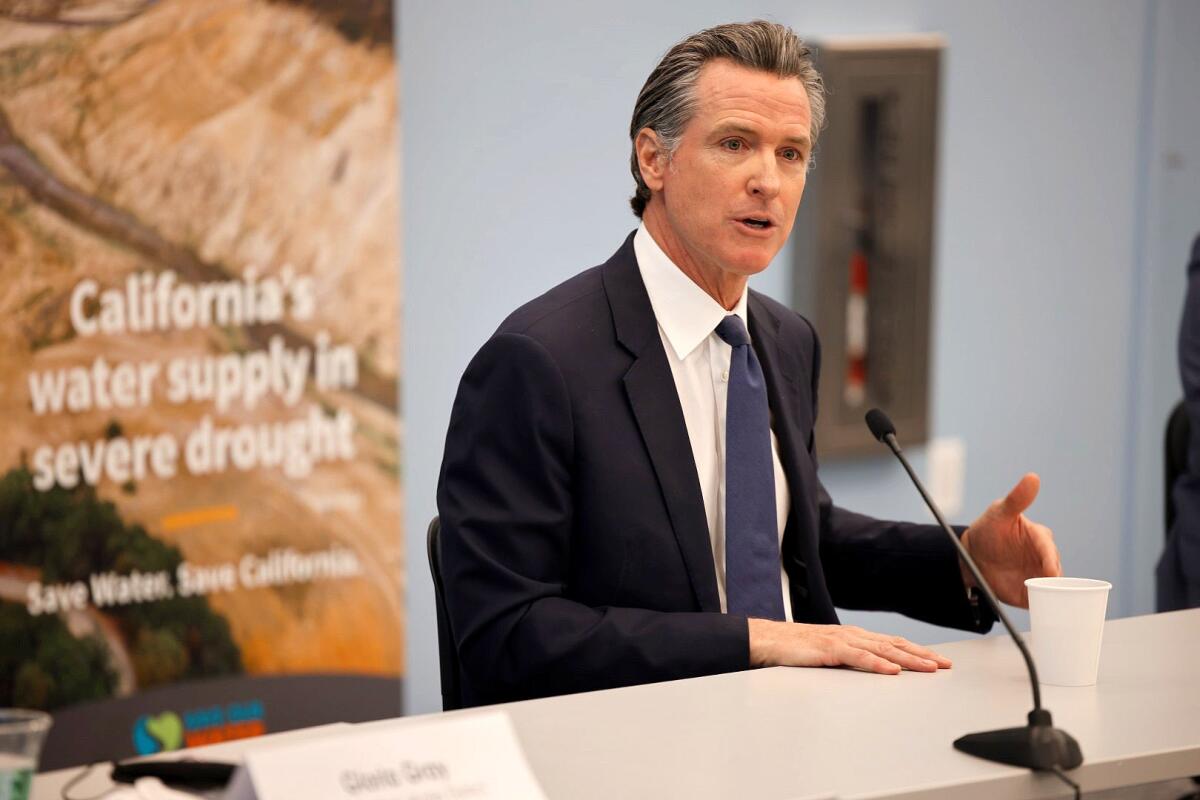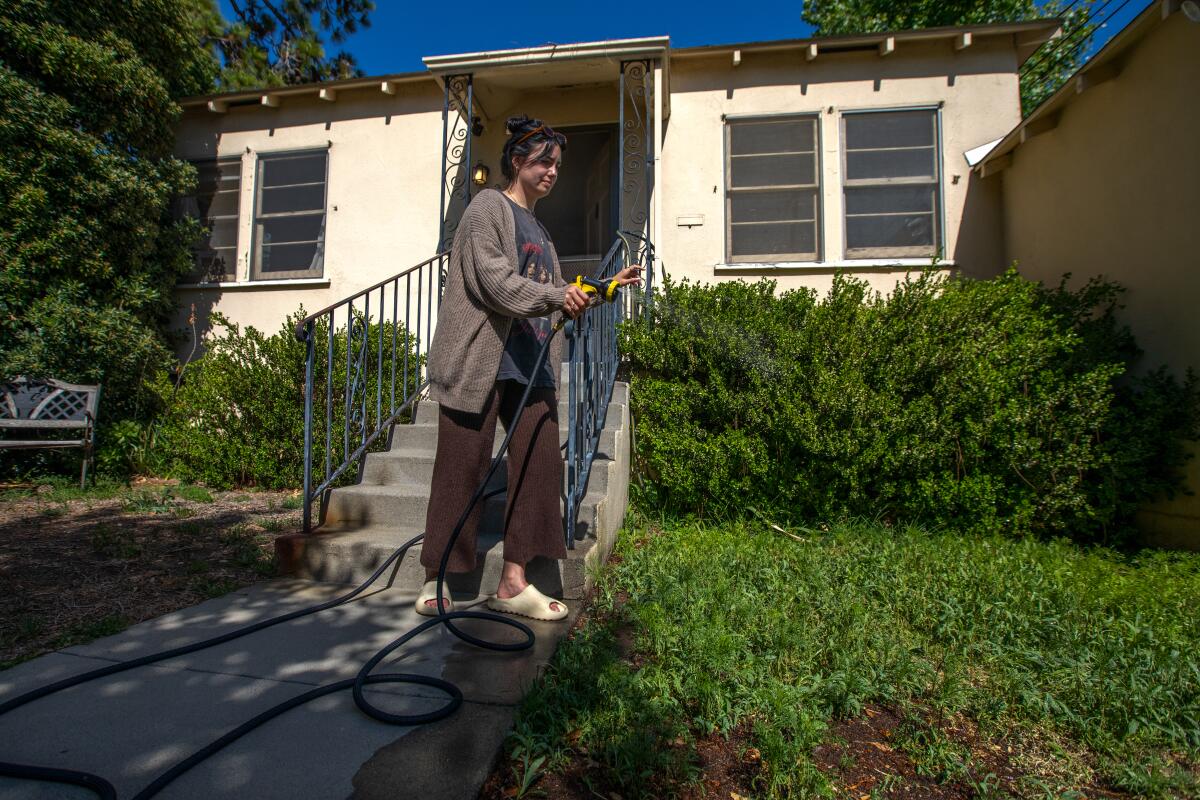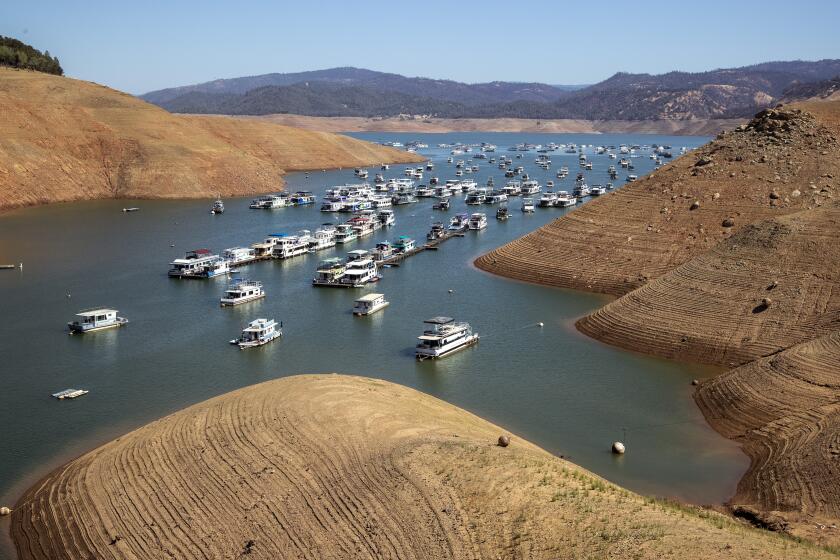Newsom urges aggressive water conservation and warns of statewide restrictions

- Share via
Gov. Gavin Newsom met with leaders of the state’s largest urban water suppliers Monday and implored them to step up efforts to get people to reduce water use as California’s drought continues to worsen. He warned that if conservation efforts don’t improve this summer, the state could be forced to impose mandatory water restrictions throughout the state.
Ten months ago, Newsom called for Californians to voluntarily cut water use 15%, but the state remains far from that goal.
The latest conservation figures have been especially poor. Water use in cities and towns increased by nearly 19% in March, an especially warm and dry month. Compared with a 2020 baseline, statewide cumulative water savings since July have amounted to just 3.7%.
“Every water agency across the state needs to take more aggressive actions to communicate about the drought emergency and implement conservation measures,” Newsom said in a statement. “Californians made significant changes since the last drought but we have seen an uptick in water use, especially as we enter the summer months. We all have to be more thoughtful about how to make every drop count.”

For part of the 2012-16 drought, then-Gov. Jerry Brown ordered a mandatory 25% reduction in urban water use. Many Californians responded by cutting back and taking steps such as converting lawns to drought-tolerant plants.
Local water agencies told state officials they preferred an approach that allowed for greater flexibility and would be more tailored to their local situations. Newsom has favored a locally driven approach. But the governor’s office said in a statement that Newsom “voiced concerns today given recent conservation levels around the state.”
“Gov. Newsom warned that if this localized approach to conservation does not result in a significant reduction in water use statewide this summer, the state could be forced to enact mandatory restrictions,” his office said. “The governor will reconvene these same agencies in the next two months to provide an update.”
Despite official calls for conservation, California cities and towns increased water use by 19% in March.
Monday’s meeting was not open to the public and was not aired live. Officials who attended the meeting at the California Natural Resources Agency, in Sacramento, included leaders of the Metropolitan Water District of Southern California, Los Angeles Department of Water and Power, San Diego County Water Authority, East Bay Municipal Utility District and other large water suppliers. Their agencies together supply water to about two-thirds of Californians.
Newsom issued an executive order in March calling for local water agencies to implement more aggressive conservation measures. Following that order, the State Water Resources Control Board will vote Tuesday on emergency regulations that require local water suppliers to activate “Level 2” of their local contingency plans to prepare for a shortage of up to 20%. The regulations also include a statewide ban on using potable water to irrigate “non-functional” grass at commercial, industrial and institutional properties — which include homeowners’ associations as well as businesses.
About half of California’s population is now under water restrictions implemented by local water agencies, according to the governor’s office. If the state water board approves the emergency regulations, every urban area throughout the state will be covered by a local plan for reducing water use.
The severe drought, now in its third year in California, is one of the most extreme on record and has been worsened by hotter temperatures with global warming. The first three months of the year were the driest on record. The state’s largest reservoirs are now at about half their average levels.
Across the western U.S., scientists have found that the extreme dryness since 2000 has become the driest 22-year period in at least 1,200 years, a megadrought that research shows is being intensified by climate change.
Some scientists describe the trend as aridification and say the West must prepare for heat-driven drying to continue as temperatures climb with the burning of fossil fuels and rising levels of greenhouse gases.
Newsom has proposed an additional $2 billion this year for drought response efforts.
The state government has scaled up its drought campaign, called Save Our Water, and is urging Californians to conserve by taking steps such as limiting outdoor watering, taking shorter showers and washing full loads of clothes.
Adel Hagekhalil, general manager of the Metropolitan Water District, attended Monday’s meeting and said the district supports Newsom’s call for reducing water consumption to stretch California’s shrinking supplies ahead of the summer months.
“We appreciate the governor’s collaborative approach in addressing statewide drought conditions by allowing water agencies to determine the water savings actions appropriate for the specific circumstances of their communities,” Hagekhalil said in a statement. “Different parts of our state have different water supply sources and are being affected by the state’s drought differently.”
The Metropolitan Water District in April declared a water shortage emergency and ordered restrictions on outdoor watering in parts of Los Angeles, Ventura and San Bernardino counties that rely on the hard-hit State Water Project, which transports water southward from the Sacramento-San Joaquin River Delta. The water restrictions are set to take effect June 1 and are aimed at reducing water use by about 35%.
Though Newsom’s meeting with managers of water agencies focused on improving conservation in urban areas, the drought is also affecting agriculture and food production. Many growers have seen their water deliveries cut sharply, and have turned to pumping more groundwater or leaving some farmland dry and unplanted.
Of the water that’s diverted and pumped in California, state data show that on average about 80% is used by agriculture while the other roughly 20% is used by cities and towns.
In a recent report for the California Department of Food and Agriculture, researchers calculated that reduced water deliveries resulted in 395,000 acres of cropland left dry and unplanted last year — an area larger than Los Angeles.
The researchers calculated that the drought last year caused the state’s agriculture industry to shrink by an estimated 8,745 jobs and shoulder $1.2 billion in costs due to water cutbacks. Those costs are expected to grow this year as more farmland in the Central Valley is left dry.










